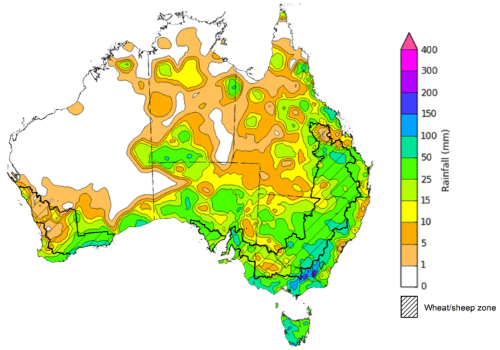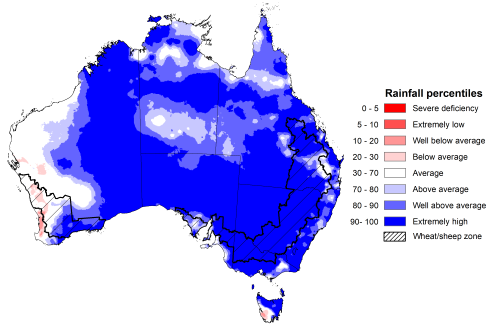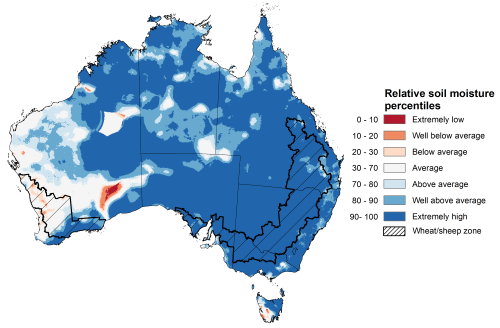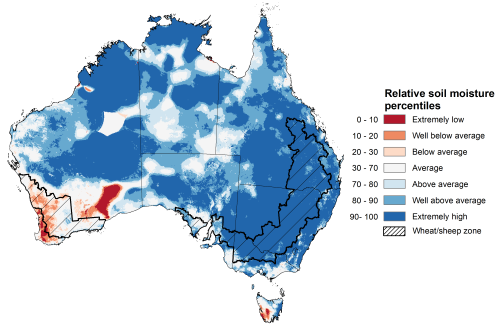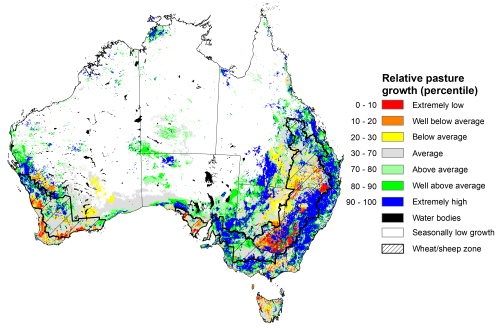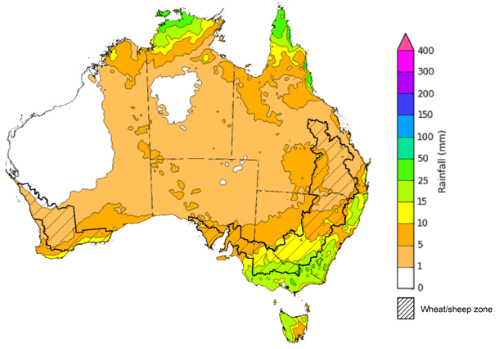Key issues
- For the week ending 2 November 2022, low-pressure systems and surface troughs brought extensive rainfall to eastern, central and southern Australia. Weekly rainfall totals exceeding 50 millimetres were observed in the south and east of Victoria, much of Tasmania, as well as parts of eastern New South Wales, east-central Queensland, and southern parts of Western Australia.
- Rainfall during October 2022 was the second highest October on record for Australia as a whole, and the highest on record in New South Wales, Victoria and the Murray-Darling Basin. Significant flooding events occurred in large parts of eastern Australia, in some cases lasting for prolonged periods and recurring in multiple events throughout October.
- Soil moisture levels for October 2022 was extremely high for this time of year across much of New South Wales, Victoria, Queensland and South Australia, as well as parts of Western Australia, Tasmania and the Northern Territory, reflecting high monthly rainfall in these areas. For growers in eastern Australia, soil moisture levels, particularly in low lying areas, is delaying the harvesting of winter crops and the planting of some summer crops. Where fields are not waterlogged, the above-average soil moisture levels observed across much of eastern Australia will likely benefit summer crop germination and establishment.
- For the 3 months to October 2022 above average rainfall totals and mild temperatures resulted in well above average pasture production for this time of year across most grazing regions in eastern and southern Australia. This growth will likely enable farmers to continue rebuilding stock numbers and provide opportunities to replenish fodder supplies during late spring.
- Over the 8-days to 10 November 2022, high-pressure systems over southern Australia are forecast to bring limited rainfall across much of central and western Australia. Meanwhile, low-pressure systems are forecast to bring moderate rainfall to northern parts of Queensland and the Northern Territory as well as south-eastern Australia. The slight easing of wet conditions across flood-affected cropping regions of eastern Australian will likely allow floodwaters to recede and reduce the risk of waterlogging and fungal diseases. The forecast drier conditions are also expected to provide an opportunity for soils to drain and allow improved access to fields for harvest and disease management.
- Water storage levels in the Murray-Darling Basin (MDB) decreased between 25 October 2022 and 1 November 2022 by 75 gigalitres (GL). Current volume of water held in storage is 23 959 GL which represents 95 per cent of total capacity. This is 8 percent or 1715 GL more than at the same time last year.
- Allocation prices in the Victorian Murray below the Barmah Choke increased from $30 per ML on 21 October to $36 per ML on 28 October 2022. Prices are lower in regions above the Barmah choke due to the binding of the Barmah choke trade constraint.
Climate
For the week ending 2 November 2022, low-pressure systems and surface troughs brought extensive rainfall to eastern, central and southern Australia. Weekly rainfall totals exceeding 50 millimetres were observed in the south and east of Victoria, much of Tasmania, as well as parts of eastern New South Wales, east-central Queensland, and southern parts of Western Australia. High-pressure systems over western and northern parts of the country resulted in mostly dry conditions in much of Western Australia, the Northern Territory and western parts of Queensland.
In Australian cropping regions, rainfall totals of between 15 and 100 millimetres were recorded across much of Queensland, New South Wales and South Australia, as well as parts of Victoria and the southern half of the Western Australian wheatbelt. Little to no rainfall was recorded in remaining cropping regions of Western Australia, south-western Victoria and northern Queensland for the week ending 2 November 2022.
Heavy rain across New South Wales, Victoria, Queensland and Tasmania has led to continued major flood heights across several river catchments. The flooding events in eastern Australia have caused damage to agricultural and transport infrastructure and are expected to cause significant crop losses for some growers. However, the full extent of damage is yet unknown. Moderate to heavy rainfall across cropping regions in eastern Australia has interrupted the harvesting of winter crops and the sowing of summer crops.
Rainfall for the week ending 2 November 2022
Note: The rainfall analyses and associated maps utilise data contained in the Bureau of Meteorology climate database, the Australian Data Archive for Meteorology (ADAM). The analyses are initially produced automatically from real-time data with limited quality control. They are intended to provide a general overview of rainfall across Australia as quickly as possible after the observations are received. For further information go to http://www.bom.gov.au/climate/rainfall/
Rainfall during October 2022 was the second highest October on record for Australia as a whole, and the highest on record in New South Wales, Victoria and the Murray-Darling Basin. Monthly rainfall totals for October ranged from above average to extremely high for much of Australia. Significant flooding events occurred in large parts of eastern Australia, in some cases lasting for prolonged periods and recurring in multiple events throughout October. In contrast, rainfall was below average for isolated parts of western and central Western Australia, as well as parts of south-western Tasmania.
The main climate influences for October were a negative Indian Ocean Dipole (IOD), a positive Southern Annular Mode (SAM) and the continued La Niña event in the Pacific Ocean. A negative IOD typically results in enhanced rainfall in a broad band extending from the north-west to the south-east of Australia. A positive SAM is associated with increased rainfall across parts of eastern Australia but less rainfall for parts of southern Australia. La Niña events tend to increase rainfall across eastern, central and northern Australia.
October 2022 rainfall was extremely high across cropping regions of New South Wales, Queensland, Victoria, south-eastern parts of South Australia and southern parts of Western Australia. October rainfall was below average for some northern parts of Western Australian cropping regions but generally average for remainder of Western Australian cropping areas.
Extremely high rainfall across eastern Australia in October followed a wet start to the winter cropping season and well above average rainfall across much of Australia in September 2022. The persistent wet conditions have exacerbated waterlogging in low lying areas, negatively impacting winter crop development. The continuation of wet conditions has also increased fungal disease pressure and limited field access for harvesting and disease management. In some cropping regions across eastern Australia, harvesting of winter crops has been delayed by the wet conditions. However, harvesting is nearing completion in Central Queensland and is now underway in New South Wales, Victoria and South Australia. Yield potentials remain very favourable for crops not impacted by waterlogging and fungal diseases.
Rainfall percentiles for October 2022
Upper layer soil moisture for October 2022 was extremely high for this time of year across much of New South Wales, Victoria, Queensland and South Australia, as well as parts of southern and north-western parts of Western Australia, north-western Tasmania and large areas of the Northern Territory, reflecting high monthly rainfall in these areas. Below average upper layer soil moisture was evident across isolated parts of the east and south-west of Western Australia, and south-western Tasmania. Modelled upper layer soil moisture was generally average to above average across the remainder of the country.
At this time of year, upper layer soil moisture determines the ability of growers to access paddocks for winter crop harvesting, as well as sowing and establishment of summer crops. For growers in eastern Australia, high upper layer soil moisture levels, particularly in low lying areas, is delaying the harvesting of winter crops and the planting of some summer crops. Fungal disease risks exacerbated by wet conditions are an ongoing concern, especially as timely disease management relies on access to paddocks. However, upper layer soil moisture is also critical for supporting the germination and establishment of summer crops. Where fields are not waterlogged, the above-average upper layer soil moisture levels observed across much of eastern Australia will likely benefit summer crop germination and establishment.
Modelled upper layer soil moisture for October 2022
Source: Bureau of Meteorology (Australian Water Resources Assessment Landscape model)
Lower layer soil moisture for October 2022 was well above average to extremely high for this time of year across large parts of New South Wales, Queensland, Victoria, South Australia, as well as northern parts of Western Australia and the Northern Territory, and eastern Tasmania. Lower layer soil moisture was below average to extremely low in isolated parts of southern Western Australia and western Tasmania. Modelled lower layer soil moisture was generally average across the remainder of the country.
Lower layer soil moisture will be important for winter crops as they finish grain filling over the coming weeks and help support summer crops and pasture growth during a peak growth period.
In Australian cropping regions, lower layer soil moisture was well above average to extremely high across much of New South Wales, Queensland, northern Victoria, and central and eastern South Australia. Lower layer soil moisture was generally average or just above average across remaining cropping areas of New South Wales, Victoria and South Australia. In contrast, much of the cropping regions of Western Australia are experiencing average or below average lower layer soil moisture.
Well above average to extremely high lower layer soil moisture levels across New South Wales, Queensland and northern Victorian cropping regions present a potential downside risk to yields. These areas are expected to receive well above median rainfall over the next three months, increasing the risk that saturated soils and waterlogging will persist and reduce yield potentials. High lower layer soil moisture levels during October also provide a reserve of plant-available water for summer crops later in the growing season.
Modelled lower layer soil moisture for October 2022
Source: Bureau of Meteorology (Australian Water Resources Assessment Landscape model)
Pasture growth during the August to October period is typically low across large areas of central and northern Australia as it is firmly in the dry season. Across southern Australia, August to October pasture growth provides the spring flush which typically allows producers to cease winter supplementary feeding with grain and hay. It also influences the growth, branding and marking rates of lambs and calves, and the production of meat, milk, and wool over this peak production period.
For the 3 months to October 2022 above average rainfall totals and mild temperatures resulted in well above average pasture production for this time of year across most grazing regions in eastern and southern Australia.
Modelled pasture growth was above average to extremely high across large areas of New South Wales, Victoria, and Western Australia, as well as south-eastern Queensland and southern South Australia. This growth will likely enable farmers to continue rebuilding stock numbers and provide opportunities to replenish fodder supplies during late spring, if suitable fodder conservation conditions arise. In contrast, modelled pasture growth was extremely low to below average across scattered areas of central and southern New South Wales, southern Queensland, South Australia, and southern parts of Western Australian grazing areas. In some regions this low pasture growth likely reflects a decline in plant growth due to excess moisture.
Relative pasture growth for 3-months ending October 2022 (1 August to 31 October 2022)
Source: Queensland Department of Science, Information Technology and Innovation
Over the 8-days to 10 November 2022, high-pressure systems over southern Australia are forecast to bring limited rainfall across much of central and western Australia. Meanwhile, low-pressure systems are forecast to bring moderate rainfall to northern parts of Queensland and the Northern Territory as well as south-eastern Australia.
In Australian cropping regions, rainfall totals of between 10 to 25 millimetres are expected across much of southern New South Wales and Victoria, as well as southern parts of the Western Australian wheatbelt. Little to no rainfall is forecast for remaining cropping regions during the next 8-days.
The slight easing of wet conditions across flood-affected cropping regions of eastern Australian will likely allow floodwaters to recede and reduce the risk of waterlogging and fungal diseases. The forecast drier conditions are also expected to provide an opportunity for soils to drain and allow improved access to fields for harvest and disease management.
Yield potentials for crops not impacted by flooding in south-eastern Australia remain very favourable. If this rainfall forecast is realised, it should allow for the harvesting of winter crops and provide ideal conditions for planting of summer crops across Queensland and New South Wales in the coming weeks.
The outlook for winter crops across South Australia and Western Australia remains very promising, as ideal conditions for the season to-date have established strong yield potentials. With little rainfall forecast for cropping regions in South Australia and Western Australia over the next week, this should provide favourable conditions for crop maturation and harvesting activities.
Total forecast rainfall (mm) for the period 3 November to 10 November 2022
Note: This rainfall forecast is produced from computer models. As the model outputs are not altered by weather forecasters, it is important to check local forecasts and warnings issued by the Bureau of Meteorology.
Water
Water storages, water markets and water allocations - current week
The Tableau dashboard may not meet accessibility requirements. For information about the contents of these dashboards contact ABARES.

